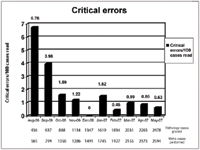- Case-Based Roundtable
- General Dermatology
- Eczema
- Chronic Hand Eczema
- Alopecia
- Aesthetics
- Vitiligo
- COVID-19
- Actinic Keratosis
- Precision Medicine and Biologics
- Rare Disease
- Wound Care
- Rosacea
- Psoriasis
- Psoriatic Arthritis
- Atopic Dermatitis
- Melasma
- NP and PA
- Skin Cancer
- Hidradenitis Suppurativa
- Drug Watch
- Pigmentary Disorders
- Acne
- Pediatric Dermatology
- Practice Management
- Prurigo Nodularis
- Buy-and-Bill
Article
Proficiency in reading Mohs pathology sections product of time, volume
A study tracking the performance of a Mohs surgery fellow in Mohs histopathology section interpretation and mapping found that it took nearly 1,500 Mohs cases which generated 1,350 pathology specimens that were reviewed and immediately graded before the error rate fell to an acceptable level.

Key Points

In collaboration with his Mohs fellowship directors, Dr. Murphy analyzed errors made in interpretation of Mohs histopathology sections during the course of his fellowship.
The primary endpoint was the number of slides needed to reduce the rate of "critical errors" below 1 per 100 cases read.

The threshold of 1 critical error per 100 cases read was selected because it coincides with the published 98 percent to 99 percent cure rate of Mohs micrographic surgery for common tumors (basal cell and squamous cell carcinomas, BCC, SCC).
Mission critical
The analyses showed that the critical error rate did not fall below the targeted threshold level for more than six months, until Dr. Murphy had interpreted pathology slides from 1,491 Mohs surgery cases and was the initial reviewer for 1,347 slides.
"Its results demonstrate that Mohs surgery is not a technique that can be learned well after reading a low volume of cases in a short time of just weeks or even a few months," Dr. Murphy tells Dermatology Times.
"We believe the findings also legitimize the criteria established by the American College of Mohs Micrographic Surgery and the Accreditation Council for Graduate Medical Education-approved fellowships that require a minimum of 500 cases for appropriate training and minimization of potential errors."

Quantifying, qualifying errors
To track his competency, Dr. Murphy would initially read the Mohs histopathology sections independently and record his interpretation on the Mohs map in pencil.
Then, he reviewed the cases at a dual-headed microscope together with one of the Mohs program directors, who marked the map definitively in red ink. Critical errors, e.g., missed tumor or incorrect mapping, were assigned a score of "3."
Other types of errors were recorded as "significant" or "of minimal consequence."
A significant error was defined as an error in interpretation and mapping that could lead to unnecessary removal of additional tissue - e.g., the fellow believes there is residual tumor, but the program director determines the margins are clear - and it was assigned a score of 2 points.
An error of minimal consequence was defined as a situation in which there was a difference in the fellow's and director's judgment, but a clear-cut right or wrong answer could not be definitively determined.
"A classic example of such an error would be an equivocal case where neither I nor the program director could definitively determine between follicular basaloid proliferation and basal cell carcinoma," Dr. Murphy explains.
Errors of minimal consequence were assigned a score of "1," and concordant interpretations were assigned a score of "0."
During the second month of his fellowship, Dr. Murphy's critical error rate was 6.78 per 100 cases read. It dropped to 3.98 the next month, and continued to fall thereafter. During month six of his fellowship, Dr. Murphy had no critical errors. The critical error rate rose to 1.52 per 100 cases read the next month, but remained consistently below 1 during the remaining months of the study.
Take-home message
"Clearly, my interpretation skills got better as the number of slides I read increased.
"However, the opportunity to review my initial interpretations immediately with a proctor was really key to help me move along the learning curve. An active cognitive and immediately proctored style of learning seems optimal because it provides a method for learning from one's mistakes so that they can be reduced or eliminated in the future," Dr. Murphy says.
A similarly designed, multi-institutional study is now under way involving six fellowship programs.






